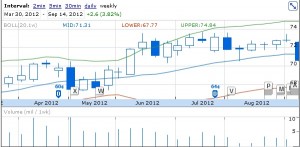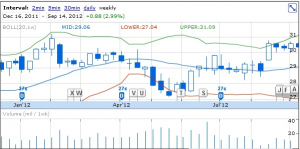We do have a transaction in the speculative alternatives portfolio today. We’re buying Clorox (CLX) to cover and selling the associated hedge. Here was the portfolio before the transaction:
Short 18% ABT
Long 5.8% SPY as beta hedge for ABT
Short 18% CLX
Long 6.8% SPY as beta hedge for CLX
Short 18% JNJ
Long 9.7% SPY as beta hedge for JNJ
Short 18% NWN
Long 4.7% SPY as beta hedge for NWN
Short 18% PEP
Long 8.6% SPY as beta hedge for PEP
Long 18% SPY as trend follow
Short 15% GLD as trend follow
the seperate SPY positions add up – net long 53.6% SPY.
Since CLX has now regressed back to the average price line, we’re going to exit our spread. Here’s the price move that triggered the change:
The new portfolio will look like:
Short 18% ABT
Long 5.8% SPY as beta hedge for ABT
Short 18% JNJ
Long 9.7% SPY as beta hedge for JNJ
Short 18% NWN
Long 4.7% SPY as beta hedge for NWN
Short 18% PEP
Long 8.6% SPY as beta hedge for PEP
Long 18% SPY as trend follow
Short 15% GLD as trend follow
the seperate SPY positions add up – net long 46.8% SPY.
Now we’re got a minor dilemma – do we add an additional position? We’ve got a slot open and 5 unusued stocks. Four of them have price that’s clearly unsuitable, but Sysco (SYY) is a possibility:
The only difficulty here is that the real entry signal was 2 weeks ago. We didn’t do anything with it then because all five lanes of the portfolio were in use. But we would have taken the position then if we’d had a lane available. The question is whether we jump in late. It may make very little difference. The speculative alternatives method is designed to be robust to that sort of sloppiness but I have no data on how late entries affect performance. It’s possible they’re more likely to run away on us. So personally I’m going to trade this one on paper only and start building up data. Plus the portfolio is a little more comfortable margin wise when we don’t have all five lanes used in the same direction. That gets a bit tight. So for now we’ll leave one lane empty.
Performance-wise, we were 4.2% up since inception when I last wrote. We’re now almost exactly 6% up, meaning the last three weeks have been slightly better than our previous results. We don’t have enough track record to get too excited about average performance, but things are still moving in the right direction at the right rate.

